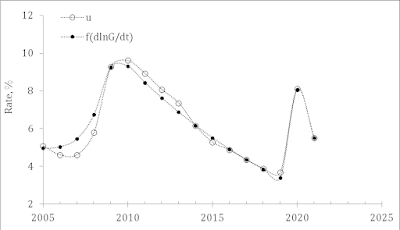Девальвация валюты — это
процесс, отличный от инфляции цен, которая обусловлена только
внутриэкономическими факторами. "Вертолетные" деньги, вливаемые в
экономику, эквивалентны девальвации: человек получает больше единиц платежа без
соответствующего изменения количества товаров и услуг для покупки. Федеральная
резервная система США вводила в экономику деньги через различные механизмы с
2009 года, как показано на рисунке 1 (заимствовано с веб-сайта Federal Reserve). Можно
видеть, что всплеск 2020 года был чрезвычайно большим как взрыв. Мы уже
обсудили этот эффект и описали его влияние на текущие оценки инфляции в этом
блоге. Мы ожидаем ценовой дефляции во второй половине 2022 года.
Модель, связывающая скорость
изменения реального ВВП на душу населения, rGDPpc, и уровня безработицы, u, критически зависит от точности оценок обоих параметров.
Реакция на меры Федеральной резервной системы в период с 2009 по 2020 год
должна быть аналогична реакции на рост активов в 2020 и 2021 годах —
девальвация, проявляющаяся в виде ценовой инфляции. Разницу между реальным
экономическим поведением и денежными спекуляциями следует рассматривать в
долгосрочной эволюции экономической связи между rGDPpc и u.
Как видно из рис. 1, фактор девальвации до 2009 г. отсутствовал. Таким образом,
введение столь значимого фактора в основные экономические показатели (влияние
совокупного количества денег на номинальный ВВП) должно было проявляться в виде
структурного разрыва в долговременной функциональной связи rGDPpc и u. Такой
разрыв мы нашли в 2010 г. – коэффициент линейной регрессии составлял -0,465 до
2010 г. и только -0,26 после. Эти оценки были сделаны методами, основанными на
среднеквадратичных ошибках. Константа регрессии также изменилась с 0,907 до
-0,25. Изменение этих коэффициентов позволило сопоставить данные за период с
2010 по 2019 год, как показано на рисунке 2. Коэффициенты регрессии,
рассчитанные для периода между 1979 г. (год значительного пересмотра определения
ВВП и безработицы) и 2009 г. (показаны красным), не могут предсказать уровень
безработицы на основе реального ВВП на душу населения. Тем не менее, даже
обновленная модель выходит из строя в 2020 году, о чем говорится в этом посте.
Учитывая (вертолетные) деньги,
влитые в экономику США, мы предполагаем, что экономически обоснованные оценки
реального ВВП на душу населения были искажены девальвацией, добавленной к
фактической инфляции цен. Эта гипотеза предполагает, что реальные значения ВВП
были занижены, поскольку уровень инфляции в США был завышен. При компенсации на
девальвацию коэффициенты регрессии, полученные за период с 1979 по 2009 год,
должны быть действительными, и мы можем оценить rGDPpc из u, используя
долгосрочную связь. Чтобы спрогнозировать правильный уровень инфляции и,
следовательно, реальный ВВП, мы ввели линейную функцию инфляции, изменяющуюся с
3,8% в 2010 г. до 2,8% в 2019 г. - впрыск денег не был постоянным во времени.
На рис. 3 сравниваются опубликованные и скорректированные оценки rGDPpc, а на рис.
4 представлено соответствие модели между 2010 и 2019 годами с исходными
коэффициентами регрессии. На рисунке 5 сравниваются скорости изменения rGDPpc для
скорректированных и опубликованных значений. Фактические темпы инфляции цен
были ниже опубликованных на разницу между скорректированными и опубликованными
значениями rGDPpc,
как показано на рисунке 6.
Поправка инфляции цен на девальвацию,
вызванную действиями ФРС, предполагает,
что реальный ВВП на душу населения рос в среднем на 3,2% в год в период с 2010
по 2019 год вместо опубликованного значения (в среднем) 1,5% в год за тот же
период. Это результат денежной поддержки Федеральной резервной системы. Эта
разница в скорости изменения в 1,7% соответствует общей сумме активов ФРС: ВВП примерно 20 трлн в год, умноженный на 0,017 =
0,34 трлн в год, или 3,4 трлн всего в период с 2010 по 2019 год. Это означает, что все деньги, влитые ФРС в экономику, в нее попали и вызвали общее повышение цен ровно на сумму повышения активов ФРС. Таким образом
связь rGDPpc-u в период между 1979 и 2009 годами все еще работает при очистке данных
по инфляции. На рис. 4 показана измеренная кривая уровня безработицы на основе
этой связи. Для прогнозируемой кривой реальный ВВП на душу населения должен
упасть на 8,1% в 2020 г. и увеличиться на 7,5% в 2021 г. На рис. 4 представлена
оценка на 2021 г.: 67200 долл. США.
Рисунок 1. Активы Федеральной резервной системы

Рис. 2. После 2010 г. связь между rGDPpc и u с обновленными
коэффициентами регрессии (черный) и с коэффициентами регрессии, полученными за
период с 1979 по 2009 г. (красный). До 2010 г. исходный временной ряд
представлен черными точками.
Рисунок 3.
Опубликованный (красный) и скорректированный (черный) реальный ВВП на душу
населения в период с 2010 по 2020 год. Модельная оценка на 2021 год составляет
67200 долларов США.
Рисунок 4. Соответствие между измеренным и прогнозируемым
уровнем безработицы для скорректированного rGDPpc.
Рисунок 5. Скорость изменения rGDPpc для
опубликованных и скорректированных оценок.
Рисунок 6. Разница между опубликованным и
скорректированным уровнем инфляции, полученная из рисунка 5.













































